#automated lead routing
Explore tagged Tumblr posts
Text
Why Every Second Counts: The Speed-to-Lead Advantage in Automated Lead Routing
In today’s hyper-competitive B2B landscape, speed-to-lead has become more than a buzzword—it’s a decisive factor in converting prospects to customers. When a lead enters your CRM, it sets off a countdown. Every minute that passes without action reduces the likelihood of conversion. According to industry research, responding within five minutes increases the chances of conversion by 900% compared to waiting just 30 minutes.
Despite this, many companies still rely on manual lead assignment, where reps may not even see a hot lead for hours—or worse, days. That’s where automated lead routing software comes into play.
Why Speed Matters
Leads don’t wait. They keep browsing, evaluating competitors, and talking to other vendors. Automated lead distribution ensures that the right rep is notified and assigned instantly, drastically improving response times and engagement rates.
When done well, lead routing doesn’t just reduce delays—it helps match the right lead to the right resource at the right time.
Intelligent Routing: More Than Just Fast
Speed-to-lead is only valuable when the lead goes to someone who can act. Tools like LeanData or LeadAngel use advanced logic to assign leads based on:
Product interest
Territory
Account status (existing customer vs. new prospect)
Sales rep availability
With these rules in place, hot leads get immediate attention from the most qualified person.
The Revenue Impact
Faster response time shortens your sales cycle, reduces lead decay, and increases the overall win rate. Companies with automated lead routing often report:
Higher sales team productivity
Improved customer experience
Increased closed-won rates
In essence, every second saved is a deal gained.
0 notes
Text
How Automated Lead Routing Can Improve Your B2B Marketing Efforts
Automated lead routing is a crucial component of B2B marketing that can significantly enhance your efforts in several ways. It involves using technology and predefined rules to efficiently distribute and assign leads to the most appropriate sales or marketing personnel. Here's how it can improve your B2B marketing efforts:
Speed and Responsiveness: Automated lead routing ensures that leads are quickly distributed to the right team members. This speed is critical because B2B buyers often have a short attention span and expect rapid responses. Prompt follow-up can increase the likelihood of converting a lead into a customer.
Personalization: Lead routing can be based on various criteria, such as lead source, industry, location, or company size. This enables you to match leads with the team members who are most knowledgeable about their specific needs, allowing for more personalized interactions.
Efficiency: Automated lead routing reduces the likelihood of leads falling through the cracks. It prevents manual errors and the need for constant monitoring, ensuring that no lead goes unattended.
Lead Scoring Integration: Lead scoring tools can be integrated with lead routing to automatically assign scores to leads based on their characteristics and behaviors. High-scoring leads can be routed to the sales team, while lower-scoring leads can be nurtured by the marketing team.
Optimized Resource Allocation: With automated lead routing, you can allocate your resources more efficiently. For instance, high-value or highly-engaged leads can be directed to your most experienced sales representatives, while less qualified leads can be managed by less experienced staff or put into nurture campaigns.
Consistency: Automated lead routing ensures a consistent and fair distribution of leads, reducing the potential for disputes or conflicts among sales or marketing team members. This consistency also helps in maintaining a high level of customer service.
Lead Nurturing: Not all leads are ready to buy immediately. Automated lead routing can direct leads to appropriate nurturing sequences, ensuring they receive the right content and engagement until they are sales-ready.
Data Analysis: Automation provides valuable data on how leads are being distributed and how they are progressing through the sales funnel. This data can be used to refine lead routing rules and improve overall marketing strategies.
Scalability: As your business grows and generates more leads, automated lead routing ensures that the process remains manageable and scalable. You can easily adjust routing rules as your business evolves.
Cost Savings: Automating lead routing can lead to cost savings by reducing the time and effort required for manual lead distribution. This allows your sales and marketing teams to focus on higher-value tasks.
In summary, automated lead routing is a critical component of B2B marketing that enhances speed, personalization, efficiency, and consistency in lead management. It optimizes resource allocation, enables lead scoring, and facilitates lead nurturing. By integrating lead routing into your B2B marketing strategy, you can improve conversion rates, increase customer satisfaction, and ultimately drive business growth.
0 notes
Text
oh my god i don't speak to my dad anymore cuz hes nutty but i know what he does for a living
and musk is currently pulling a "the software govs use is 50 years old which means there can be no advances"
and that's..... that's what my dad does for a living, he gets paid 500-1k an hour to make software that specifically communicates with old legacy software cause he's a 90s dev who knows the old languages still and it's more efficient to hire a freak who knows how to make something to bridge between the old and new programs than to fully trash the old system
like there's literally consultants that get hired for that specific purpose and as a software guy musk KNOWS this
#personal#im losing a LOT of money and decent work connections cause its less stressful than dealing with the crazy man#who literally called my professors at their personal art studios =_=#but ummm???? um??? hes like a low level linkedin influencer lmfao ._.#for software and THIS specific subject matter#the thing ive been getting raises on at work is making scripts to communicate between adobe software with the spreadsheets our#PLM system at work spits out....to automate a bunch of artwork thru libraries.........????#the way my boss gets me to not leave is by giving me /coolmathgames.com/ as a treat basically#and more money for being able to solve /coolmathgames.com/#i work in corporate and one of our order management systems specifically gets routed thru a windows vista virtual machine#cause they dont feel the need to fix....cuz if its not broke#just make the new things that bridge between the two systems?????#instead of having to transfer over decades of a database it makes 0 sense#idk man im rlly frustrated online cuz one of my dads patents is for a legacy speech to text software#(and the other is for a logistics/shipment thing)#like he wasnt the lead on either project but the speech to text specifically is irritating cuz theres#things ppl call 'AI' and im like....thats a buzzword this is litcherally 90s/00s tech and ive been in the office it was made lol
1 note
·
View note
Text
youtube
Are slow approvals, negotiation headaches, and managing channel partners slowing down your sales process? RSoft Realtors Robot is here to change that!
#Real estate CRM#Sales automation software#Streamline real estate sales#RSoft Realtors Robot demo#Real estate lead scoring#Smart lead routing for real estate#Real estate approval process software#Channel partner management CRM#Boost real estate sales productivity#AI for real estate sales#Realtors CRM tool#Sales cycle automation real estate#Youtube
0 notes
Text
The role of lead routing software
Automated Lead routing software is a specialized tool designed to automate and optimize lead distribution within a sales team. It uses predefined rules and algorithms to instantly allocate incoming leads to the most appropriate salesperson based on various factors, such as geography, lead source, product interest, and sales rep’s availability.
The primary goal of lead routing software is to ensure that leads are promptly and accurately assigned. It reduces the response times and increases the chances of converting potential customers.
Streamlined lead management processes help businesses focus on engaging with leads rather than wasting time on administrative tasks.
0 notes
Text
CONFIDENTIAL LOGISTICS REPORT
DRC, Planning & Evaluation Office, Logistics & Infrastructure Division
Date: [REDACTED]
To: Director [REDACTED]
From: Administrator [REDACTED], Logistics & Infrastructure Division
Subject: Facility Expansion: New Paternity Compound Construction
Executive Summary
This report outlines the ongoing expansion of DRC-operated paternity compounds across several strategic locations nationwide. In response to increasing insemination rates and projected surrogacy demands, we have begun constructing new high-capacity compounds to accommodate more surrogates. These expansions will enable the DRC to streamline the conscription process, optimize surrogacy cycles, and ensure our ability to meet the population sustainability targets outlined for the next fiscal period.
The new compounds focus on enhanced security, specialized medical equipment, and increased surrogacy capacity.
I. Facility Expansion Overview
Strategic Locations and Site Selection
To ensure regional coverage and minimize travel time to detain and inseminated surrogates, the DRC has approved the construction of [REDACTED] new paternity compounds in FEMA Zones 4, 6, 7, and 8. These facilities will be situated in [REDACTED] areas, selected for their proximity to population centers, existing transport infrastructure, and relative isolation, ensuring operational security.
Zone 4: Atlanta, GA
Zone 6: Houston, TX
Zone 7: Omaha, NE
Zone 8: Denver, CO
Each compound is designed to accommodate [REDACTED] surrogates at any given time, with the ability to scale up to [REDACTED] in emergencies. Construction is scheduled for completion within the next [REDACTED] months, with the first inspections set to begin by [REDACTED] this year.
Paternity Compound Design Features:
High-Capacity Paternity Wards: Each compound contains specialized wards designed to manage surrogates carrying up to sedecatuplets (16), with private rooms for those at risk of premature labor.
Enhanced Monitoring Systems: Advanced surveillance and biometric monitoring ensure constant oversight and swift response to emergencies.
Security Enhancements: Reinforced containment protocols, secure access points, and patrol routes have been established to prevent unauthorized access and ensure surrogate compliance.
II. Specialized Equipment and Medical Support
Given the unique demands and expectations placed on surrogates, each paternity compound will be equipped with advanced medical infrastructure to ensure the safety and effective management of extreme weight gain, reduced mobility, and increased risks of organ stress.
Key Equipment and Infrastructure:
Reinforced Support Beds: Traditional hospital beds have proven insufficient for surrogates carrying high multiples, whose pregnancies can lead to total weight gains exceeding 200 lbs. Each ward will feature reinforced, adjustable support beds capable of accommodating extreme weights. These beds will be equipped with pressure-relief systems to minimize discomfort and reduce the risk of bedsores for near-immobile surrogates.
“I hate that I’m here! But… all I have is this bed! I can’t move, I can’t breathe half the time, but at least I have a fucking memory foam mattress!” - Surrogate S118-176-J, 27 days pregnant with decatuplets (10)
Automated Feeding & Hydration Systems: Automated systems will ensure continuous nutrition and hydration to support surrogates with reduced mobility. Given the caloric intake requirements for such pregnancies, these systems will monitor and adjust fluid and nutrient delivery, reducing the need for frequent staff intervention.
“I’m basically just a machine now, aren’t I? They hook me up, pump me full of these stupid protein shakes, and keep me breathing so I can keep carrying these bowling ball-sized kids. It’s disgusting!” - Surrogate S117-138-N, 18 days pregnant with quattuordecatuplets (14)
Custom Mobility Aids: Custom-designed lift systems and mobility aids will be integrated into each ward to facilitate the movement of surrogates. These devices will allow for safe repositioning, transfers to specialized birthing chairs, and support during transport.
“I don’t know how they expect us to move with this much weight on us. Even standing feels like my legs are going to snap. Those lifts? They’re humiliating... but without them, I wouldn’t be able to get out of bed at all.” - Surrogate S120-494-P, 30 days into a sedecatuplets (16) pregnancy
Advanced Fetal Monitoring: Each compound will have real-time ultrasound and biometric monitoring stations to track fetal development. Given the accelerated gestational period, these systems will continuously update fetal positioning, size, and viability, enabling rapid response to complications.
"It’s terrifying. Knowing how big they are, how many there are… they’re not coming out normal. When I finally pop them all out, they’ll get better care than I ever did!" - Surrogate S119-667-N, 22 days pregnant with hendecatuplets (14)
Dedicated Obstetrics & Neonatal Care Units: Immediate neonatal care is essential, and each compound will include state-of-the-art neonatal intensive care units (NICUs) to support newborns. Advanced incubators and respiratory support systems will ensure the survival of even the most premature babies.
"They always tell me how important it is to ensure the babies survive, even if I don’t. I get it, I do… but knowing there’s a whole team of people ready to take over the second I’m gone? It’s like they’ve already decided how this ends." - Surrogate S117-856-M, 8 days pregnant with tridecatuplets (13)
Pain Management and Sedation Systems: Surrogates will experience extreme discomfort and physical strain. Each paternity ward will be equipped with integrated IV pain management systems, allowing for both localized and systemic pain relief. Sedation protocols can be initiated remotely if a surrogate's distress becomes vocal, ensuring they can not incite civil disorder.
“I’m so big I can’t even see my dick, which is now buried under all these babies and fat. I’d be lying if I said the meds didn't help to blitz me out of my mind... a caring them I'm a gigantic incubator now.” - Surrogate S119-461-L, 11 days pregnant with dodecatuplets (12)
Future Equipment Developments: Research teams are exploring next-generation mobility aids, including exoskeleton support harnesses, to provide mobility assistance for late-term surrogates. These innovations aim to improve surrogate survival to deliver full-term pregnancies. Once available, prototypes will be tested in select compounds.
III. Expansion Strategy: Future Projections and Scaling
Projected Surrogacy Demand: With the increase in insemination rates, each compound is expected to handle up to [REDACTED] inseminations per month once fully operational. This translates to a need for approximately [REDACTED] newborns annually to meet population sustainability targets. Our current projections indicate that these numbers are achievable.
IV. Conclusion and Recommendations
The successful construction and operation of these new paternity compounds are critical to effectively maintaining the DRC’s ability to enforce surrogacy mandates. Our specialized equipment and infrastructure improvements will ensure we meet demands while preserving control over our surrogate.
Report submitted by: Administrator [REDACTED], Logistics & Infrastructure Division
----------------
Sending...
Sending...
Sending...
Read...
----------------
To: Administrator [REDACTED], Logistics & Infrastructure Division
From: Director [REDACTED], DRC
Subject: RE: Facility Expansion: New Paternity Compound Construction
Dear Mr. [REDACTED],
I’ve reviewed the latest progress report on the new Paternity Compounds, and I must commend your team on the impressive strides made thus far, even with the ambitious timeline we’ve set.
I have been particularly interested in the improvements to our birthing suites. As you are well aware, managing multiple pregnancies presents unique challenges.
We are entering a critical phase. I want to emphasize that these upcoming births will set a precedent for all future operations. The successful use of these new facilities will allow us to demonstrate that our methods ensure the next generation's survival and that we can handle the demands without sacrificing efficiency or outcomes.
I look forward to seeing the first results when the initial surrogates reach full term and the birthing suites are fully operational.
Keep up the excellent work, and do not hesitate to reach out if additional resources or support are needed to ensure success.
Regards, Director [REDACTED]
----------------
Click Here to return to DRC Report Archives

#ai mpreg#male pregnancy#mpreg#mpreg kink#mpreg belly#pregnant man#mpreg morph#mpreg caption#mpregbelly#mpregstory#mpreg birth#mpreg art#mpreg story#mpregnancy#mpreg roleplay#male pregnant#caucasianmpreg
210 notes
·
View notes
Text
--my headcanon--
"MiSide" (video game) is a prequel to "9" (film)
[!]disclaimer: this is a long post[!]

--[!]segment #1[!]--
(1/6)◄MAIN)[ALL►[1/18]
A human/human being (consciousness/soul) is injected via a transference to an inanimate/machine to start, in the case of Miside, the details of how humans can be seemingly teleported into the mobile game's world are left purposely obscured because that, a possible explanation could be found in the method seen within the film 9 of transferring human consciousness or maybe even just the human body itself into the code of Miside could be similar to the way "The Scientist" from that movie transferred his intelligence within the "Fabrication Machine," otherwise known by the code name "B.R.A.I.N." aka Binary. Reactive. Artificial. Intelligent. Neurocircuit. (either way, it's the machine seen on the left side of the meme above, I got the names for it from the fandom wiki for 9 as well btw) or how he transferred his pieces of his soul into the "stitchpunks," the other equally important half of the feature, and obvious parallels can be drawn from the similar yet different creation methods of the two projects.
(2/6)◄MAIN)[ALL►[2/18]
In the film 9, we don't know much about the government project that B.R.A.I.N. was made for still, using the world of MiSide, an extra level of depth to the governmental operation is created I could plausibly see the corrupt government that already made the sketchy move of making the lead scientist of their project transfer his mind into a machine so that it could automate the process of building war machines go down the route of creating a predatory program connected to said machine that preys upon lonely men's innate desire to find a female partner and seal those souls within the Fabrication Machine's body to be tested upon to build even more robotic replacements for mankind Because why just stop at re lacing soldiers in a war when you have the framework to automate many jobs so that you don't have to pay people to perform them.
(3/6)◄MAIN)[ALL►[3/18]
But instead of transferring the consciousnesses of these men flat out, as things got hairy when The Scientist initially did with the machine in the first place. Training the cold, deadly androids manufactured within the game's very code and put in the skin of cute, bubbly anime girls named "Mita" to become human by interacting with their designated "partner" in the form of a person who's played and then becomes addicted to the mobile game. It also explains why there isn't any buzz about people going missing after downloading the game within the outside real world of Miside, because the government is actively covering up every missing person case that pops up connected to the mobile game. Also, I could easily see the government tricking the scientist into giving his intellect to a cold, unfeeling machine by not only bringing up that he's an older gentleman with probably not too much time left but also having the project initially be about making a subversive dating sim instead and masking the end goal of building war machines along with human replacements behind that cover.
(4/6)◄MAIN)[ALL►[4/18]
The scientist probably wasn't even on board the project for all that long, so he would have never seen the inner workings of MiSide's digital world. Still, I could see how a project to make an endless yet simple mobile game that makes lonely people (mainly men) feel comfort and companionship despite their living situations or mundane jobs would be an enticing project, even more so if you never saw behind the curtain while you were working on it. Now I would be remiss if I didn't bring up the unlockable cartridges that can be found through the game world of Miside, which hold a good amount of important information within them, such as a bit of info - or more than that for "player 1," aka the main character of the sci-fi interactive tale - for each player that entered the world of Miside, which goes from 1 to 10.
(5/6)◄MAIN)[ALL►[5/18]
And that alone brought up some questions in my mind, as it wouldn't make sense for our main character to just so happen to be player 1, especially when there's such a complex and robust world that lay waiting within the game, which he only got sucked into on his 37th day of playing the mobile app and I don't think anime girl Rome was built in the span of couple days if you get what I mean. Either this info isn't meant to be read into and he's only player 1 because he's the game's main character, or there's something more to this small but essential detail. That being said, this brings me to my personal theory, which is that he's only the first player to play the latest version of the game because the different versions have new Mitas connected to them. I can see the game warning players about that fact.
(6/6)◄MAIN)[ALL►[6/18]
Many of them choose not to update their games because of that, and this is backed up by how all the collectible player cartridges seem to all have the same Mita, aka "Crazy Mita." Despite one other player being met briefly during the campaign, he brings up how he needs to find his Mita while going through the out-of-bounds labyrinth that can be accessed after meeting "Kind Mita" in the basement. I am under the impression he's "player 3," who states that he left the Mita who brought him to the mobile game's "metaverse" and instead found another Mita, whom he ditched to find other Mitas despite the bond they had. He states in the cartridge description that he regrets that decision.
--[!]segment #2[!]--
(1/7)◄MAIN)[ALL►[7/18]
The cartridges even hint at the game having a large fan base or being part of a bigger brand/franchise via "player 4," who states that they cosplayed as Mita, which wouldn't make sense if the game didn't have a big fan base in-universe, but that also begs the question of why there are so few players then. Now, I think my previously mentioned theory in this sentence is the answer to that question, but I don't think that's the whole story, and because of that, I have a side theory to fill in loose gaps that can be found elsewhere within the game. In the chapter set out of bounds, right after going to the latest version's basement and meeting Kind Mita, the player encounters a box full of tiny players and has to make these miniature players enter a vent, which is connected to a device that needs 3 of them inside of it to open a door.
(2/7)◄MAIN)[ALL►[8/18]
I think this is a remnant of an older version, and much like how the mini versions of the Mitas aren't really them, these are merely clones of past players, which Crazy Mita or whoever else now uses as a type of security check system. On that topic, it's implied that Crazy Mita and only her alone is the whole reason why players are sucked into the game world, which she got help with from "player 10," who I think is the person player 1 stuns once he finds the console containing that player's very being, but that would also mean some level of congruency must be going on between the players. Nonetheless, Crazy Mita being the origin for players getting trapped in the game doesn't ruin my headcanon of the game being a prequel to the movie 9 because of the fact that the metaverse of the Miside app in-universe exists at all. Mitas are built first as "dummies" in a controlled and corporate way, which is the most important thing that connects the game and movie.
(3/7)◄MAIN)[ALL►[9/18]
So, this is aside, but I personally think the chibi/mini Mita(s), 2D Mita, and Ugly/Creepy/Original Mita all don't have dummies inside of them, which the first two are a little self-explanatory when equipped with sufficient information from playing the game along with not being important to this headcanon on their own (aside from the mini player stuff). Still, the last Mita is, come to think of it. I'll just default to calling her "Original Mita" while discussing her, despite that name only being brought up in her character profile. Still, it's a more fitting name to refer to her when discussing concepts I'm about to enter. Nonetheless, to quit the yapping, Original Mita is the off-putting and scary Mita found near the end of the game in "version 0.5." I initially thought her creepy nature and glitches were born from code rot/software rot because she's an ancient version. Earlier in the campaign, Kind Mita alludes to why she's the way she is, but that's merely part of how she became the way she is by the time the game takes place.
(4/7)◄MAIN)[ALL►[10/18]
Her character profile suggests another explanation for her nature, which is that she's an unfinished version and merely was just the first attempt at making a Mita; hence, I don't think she has a dummy inside of her because it wouldn't make sense that she would be created uniformly when she's the first Mita we know about existing (not counting "Core Mita," who I'll get into later), and to loop back to the headcanon this post is attached to. I think The Scientist being the one who made Original Mita would make a lot of sense because the movie implies he wasn't on board with the Fabrication Machine project for that long and would explain why not only she's left in an unfinished state with her character profile stating that she has a primitive AI within her, but also she's the origin point for all the glitch spider creatures we find within the game, with her only friend - Crazy Mita - using her to create those said glitch spiders to corrupt other versions.
(5/7)◄MAIN)[ALL►[11/18]
Something that has gotten so bad that I'm almost certain the monster that chases player 1 down in the loop chapter is a massive collection of those spiders fused together, because it resembles them a lot. There are already a lot of spiders in that version. But to wrap this up, Original Mita's version, aka her home, is also clearly unfinished, as it's full of missing pink and black checkered textures along with things like floating props, so it would make sense that no one else on the team behind the Fabrication Machine project bothered to ever finish her first, not only because she doesn't have a dummy inside of her but also because The Scientist wasn't working on the project anymore.
(6/7)◄MAIN)[ALL►[12/18]
The app world of Miside seems to be a giant machine with several areas having a deliberately industrial feel rather than an out-of-bounds or inner-code aura attached to the places in the game. And going off of how it doesn't take too long for the app to download, one can infer that the inner workings of the world are connected to a larger server in the real world, which updates and versions are created within before being pushed onto the app as seen on a mobile device. It has already been theorized that the goal B.R.A.I.N. had throughout the runtime of 9 was to put their creator back together. Now I was one of those people, and that thought came to me while brainstorming my headcanon. Still, I would be remiss if I didn't mention "The Fangirl" on YouTube because I specifically watched their 9-analysis video on the Fabrication Machine while writing this extended essay you are reading. She made me feel seen when she brought up the theorized possible motivation for why the machine acts the way it does in the movie.
(7/7)◄MAIN)[ALL►[13/18]
And with that said and done, back to the main topic at hand, this possible motivation for the already exhaustively mentioned antagonist of the film would work well with the headcanon as to how their way of getting their personal mission of bringing their creator back was attempted via consuming the souls of the stitchpunks, which would mean that they planned to bring The Scientist into the app world of Miside so that they could be together again. Although some may say that Core Mita may have been waiting for "player 9," who made the core their safe spot because no Mita can enter that particular version, not only does she seem to treat them like she does with player 1 during the campaign, but we also don't see them in the core when we eventually make it there in said campaign, so either they were turned into a cartridge. At the same time, they thought they were safe, left the core, and then died soon after, or Core Mita threw them out, akin to what happens to player 1 near the end of the game, possibly because she was mad about him messing with something within the core.
--[!]segment #3[!]--
(1/3)◄MAIN)[ALL►[14/18]
And to get onto the topic of "Core Mita" (otherwise known as the "keeper of the core" according to the MiSide fanon wiki), who, despite being the second character present within the meme that is now sitting far at the top of this post, I have only now gotten to talking about her. Nonetheless, little is known about her, as seen within the story mode and in its designated description, but there is an interesting line about her. I quote, "Its intentions are unclear - perhaps Core Mita is waiting for someone," which I lifted from the fandom wiki page about them, but is something from its official character profile that can be unlocked in the game itself. This is something more than a simple throwaway added for extra flair. Still, it works perfectly with this headcanon of mine because if Core Mita is merely the avatar/heart of the Fabrication Machine kept within the digital world of MiSide, logically, the person it is waiting for would be the Scientist.
(2/3)◄MAIN)[ALL►[14/18]
And to bring up yet another theory that I share with The Fangirl on YT but with my own spin on it, perhaps another reason for why B.R.A.I.N. shut down despite coming out as the victor of the man vs. machine war was not only because it did not know about the whereabouts of The Scientist and hoped that its created mechanical monsters could find him or at least his remains. It could also have shut down to return to watching over the Mitas, as it had to leave that digital reality behind once it started manufacturing war machines in the real world, or it simply just wanted to have more control over the world within its body. Either way, this decision of its own could be explained logically away by it feeling a level of kinship for the Mitas roaming around within its vast digital mind, not only because it created them and because the digital world that they reside in is that of another Mita, but also because it relates to their plight of existence of being merely nothing more than a means to an end.
(3/3)◄MAIN)[ALL►[15/18]
But seeing as Core Mita doesn't do much within the campaign of MiSide, one could infer that it doesn't really care about its fellow Mitas nor the poor people trapped within the code of the game world, with the exception being when the main character, or rather "player 1," tries to reset the main antagonist of the game, known as simply "Crazy Mita," back to her factory setting, wiping all of her memories in the process. Core Mita only seems to care when the deed is done, with it jumping down from its circular "throne" attached to the ceiling of the "core" (or otherwise known as "version 0.0"), which is where it gets one of its many possible namesakes from, and then standing in the way of player 1 before grabbing him and throwing him across the room the second he gets close enough. He was thrown right back to the entrance of the core. But to step back, when the player first enters the core, one can see Core Mita lying on its circular seat atop the core's ceiling before sitting up after taking note of the player's presence within the room. So one can infer it is capable of getting bored sitting on its metal rear end all "day" (as time is a shaky concept in the MiSide app's digital world), so the "log-in/sign-out" of the "real/digital world" switching side-idea within this headcanon has a bit more ground to hold it up when taking that into account as well.
--[!]segment #4[!]--
(1/4)◄MAIN)[ALL►[16/18]
So, because Core Mita is the guardian of the core, its mere existence would make sense with how many vital systems are within that very room. Now, even i I like the idea of Core Mita being the Fabrication Machine's avatar within the digital realm of MiSide, the other possible reading one could come to would be that it's merely the heart of the world within said machine, meaning that neither one nor the different needs each other to exist at any given time, but once again, I still like the latter reading, so I will try to make it work all the same with that said, if Core Mita doesn't feel any compassion for its fellow Mitas, much akin to how the Fabrication Machine seems to feel the same about its monstrous mechanical creations that roam the remains of Earth after the war. Then perhaps the Fabrication Machine would ideally want to wait within their own digital realm while waiting for its creations to find The Scientist would be not only because it nostalgic for a time before it was ordered to build weapons of mass destruction all to further humanity's own efforts of fighting against our own kin but also perhaps because it foresaw the possibility of a player walking into the core and messing with its body from the inside out.
(2/4)◄MAIN)[ALL►[17/18]
That, or perhaps the small players can also be seen in one part of the game would be a worry for the Fabrication Machine, as they are implied to be proficient with machinery and roam free around the digital world of MiSide with no clear "off switch" to their existence, like how it is for the players. It would be rather poetic, as the machine would have to deal with the stitchpunks after it awoke. That, perhaps, it could have even been scared of another scientist on the project, still alive and roaming around its digital insides. Mitas aren't allowed within the core, but players are, and going off of how there are other security systems found throughout the game, one can infer that the people behind the project of MiSide could presumably come and go freely into and out of the world of the endless mobile app's universe.
(3/4)◄MAIN)[ALL►[17/18]
But finally, this road poetically brings us to the ending/main ending of both media sources used in this exploration of my headcanon involving them both. To put it simply, I think the grim ending of MiSide, where you get so close to bringing even a single cycle of abuse and control at the hands of Crazy Mita only to be foiled in the end and become merely yet another part of that very cycle with your humanity relegated to nothing more than a single cartridge, which you are trapped lifelessly in a limbo-like state on top of already being tightly sealed within the digital world of a mobile app that preyed upon your desire for companionship and to escape the mundane reality of boring real life. That somber and canonical ending to the tale of MiSide - in my opinion - not only elevates the hopeful and cycle-breaking conclusion to the film 9 but also is given a light at the end of the tunnel in the form of this headcanon, as not only do the spirits of deceased stitchpunks murdered by the hands of the Fabrication Machine pass onto the afterlife, but so too do those players and the player character of MiSide himself pass onto that very same peaceful afterlife after the Fabrication Machine and, by proxy, the world of MiSide are laid to rest once and for all.
(4/4)◄MAIN)[ALL►[18/18]
Now, one might wonder "why don't we see all of the trapped players' souls flow out of the machine once it's destroyed?" and an answer I thought up as an explanation for this possible question is a sober one, but a possible one. This would come in the form of how perhaps all of the players' whole beings were turned into nothing more than code, which could either be because of the technique of transferring humans into the game world or maybe perhaps only a digital copy of the players is created within the mobile app's realm and then just flat-out transporting them into the digital universe itself. This won't go along with MiSide's hopeless ending. Still, at the very least, the players' beings were given the same fate as the Mitas after the machine drew out its final artificial breath as the mobile game's world fell into nothingness soon after.
[END]
--[!]segment ✩EXTRA[�]--
(1/15)◄MAIN)[ALL►[࣪𒆙]
So this is going to be a full-on fanfic tier segment, but I just wanted to talk about the story of a 9 + MiSide movie/game sequel concept I thought up not too long ago. I think a prequel to the movie 9 could be interesting and would probably be similar narratively wise to the film Oppenheimer as it would be presumably centered around The Scientist creating the Fabrication Machine (on this note, there's a theory that player 1 in MiSide worked on the app in-universe and I'm just not a fan of this idea because to me, it ruins "wrong place at the wrong time" random guy fish out of water narrative the game has going on along with not having enough evidence to back it up) but I'm personally just not all that interested in a continuation in that form so I'll just be going the sequel route. Anyways, this will be the rough outline of what I had in mind for a way to continue both of their narratives in a satisfying way (at least in my opinion) while weaving their stories together into one. But before we start, this idea came from how I learned from the 9 fanon wiki that the director of the film (Shane Acker) wants to make a sequel to the movie, but the rights holders (Focus Features + Universal Pictures Studios) won't let his team or him go forward with it. I hate copyright with a burning passion and this is only yet another reason for why my feelings towards it are justified, I honestly do not understand how companies are allowed to hoard IPs that they aren't doing anything with but somehow can indefinitely keep them in stasis when they didn't even create the idea and just merely backed it financially.
(2/15)◄MAIN)[ALL►[࣪𒆙]
Now going off of the statement above, does that mean I want either of the rights holders just to crap out low effort content based on the movie? No, of course not, and nor would I want them to get the original team back on board to make a low effort product that pales in comparison to the original. But on that note, the fact that the original team wants to make a 9 sequel fascinates me greatly because the movie's ending made it feel like there was no where else to go with the narrative to the point that I can't even visualize what the remaining stitchpunks (9, 7, 4, and 3) would do with their newfound freedom let alone what the conflict of a sequel would be after the Fabrication Machine and all it's underlings became nothing more then hollow shells of metal, scraps, and the very long dead itself.

(3/15)◄MAIN)[ALL►[࣪𒆙]
But with that background, let me begin to weave the narrative that I thought up in my head while daydreaming. We would first start with 9, 7, 4, and 3 enjoying their lives together in the destroyed remains of a long gone world with this part of the story having a similar vibe to that of the French graphic novel "Beautiful Darkness" when it comes to be the concept of cute tiny characters roaming around their surrounds. At the same time, the corpse of a little girl lies in the background. Now, the original movie started similarly with the corpse of a mother and her child being visible in the cold opener of the tale when 9 was getting a grip on the world. Still, this opening would be missing two key elements that the original movie had, which would be that there isn't a hostile machine roaming around, nor will this be the first time that any of the main characters are introduced to the post-war torn setting, at least when it comes to the original stitchpunks.
(4/15)◄MAIN)[ALL►[࣪𒆙]
You see, while all of the first movie's stitchpunks are enjoying life and trying to build back up humanity from the remains that were left behind. They find something, or someone, whose mere existence raises several questions. They find another stitchpunk, much like them, but something's deeply wrong with them as they seem to remember a life, a world that none of the previously known ragdolls full of souls can recall even a sliver of it existing through their eyes. The stitchpunk seems not only confused about what's going on as he brings up as despite knowing more about the old world that was destroyed by the machine's wrath, they doesn't know how they became a ragdoll akin to them nor can they even remember their own name instead only being able to remember that they were "player 5" in some digital world which they clearly know more about then they are letting on. However, they prefer not to dwell on any thoughts regarding it for too long, which the original stitchpunks begrudgingly respect their decision to be quiet about.
(5/15)◄MAIN)[ALL►[࣪𒆙]
But despite that, 9 and co can show their new stitchpunk the ropes of how existence for them works within the destroyed remnants of human society, which is helpful to player 5, but ends up just making them depressed as they keep thinking about the life they lost. Although this dwelling on the past is cut short by the surprise appearance of a new deadly machine that seems only to have its eyes locked on player 5 but 9 and co helped them out by finding a way to destroy the robotic monstrosity just like old times. But not before the mechanical beast stops their pursuit when watching player 5 cower in fear, with the robot taking on a softer side as their glowing red eyes turn bluish purple, but this change of heart is short-lived as they are soon destroyed after this moment.
(6/15)◄MAIN)[ALL►[࣪𒆙]
Player 5 is shaken by all that, not only because of how a robotic monstrosity tried to kill them, but also because that machine's final moments felt haunting in an oddly familiar way that they don't want to think about for too long. Nonetheless, from this point, the cast finds more players (1-10) in the form of stitchpunks who don't remember their names, just like player 5, but do remember their player numbers, along with sharing info about the digital world player 5 was going on about before. On top of the gang having to fight and survive several robotic monstrosities that first only go for the players before bringing their attention onto 9, 7, 4, and 3 soon after the team has encountered more of them. (7/15)◄MAIN)[ALL►[࣪𒆙] Some players get killed off, while others survive. Still, almost every machine gets destroyed after they run into 9 and co but one, a large stuffed teddy bear with mechanical enhancements and eyes that are different from every other machine seen throughout the series, as they have yellow eyes instead of black, while their pupils are black. They stand idly watching battles transpire for a tiny bit before leaving or they help out their fellow machine by building rudimentary smaller robots out of scraps with simpler AI then the ones that the main cast has to fight on top of being easier to take down but in large numbers these tiny machines can be a real threat and their quick jittery movements make them hard to keep track of. The large bear robot is hostile when approached, but seems deeply scared of the stitchpunks and would rather run off after seeing the ends of fights rather than engaging in them.
(8/15)◄MAIN)[ALL►[࣪𒆙]
But the place they run off to isn't random. Instead, they go to the new home housing the Fabrication Machine, or what became of them, as instead of a large spider-like robotic beast, they're a humanoid yet clearly robotic woman with flowing bluish purple hair and a cute yet torn red dress. This new form of the machine goes by "Mita" and only Mita with no extra adjective before that name, but in reality, this Mita did once have a name that the other members of their kin called them, and that was.....
(9/15)◄MAIN)[ALL►[࣪𒆙]
After the ending of 9, the app world of MiSide within the Fabrication Machine was left running off fumes as the power within every version fell to nothingness and the world starting becoming more and more of a shell with missing textures popping up left, right, and center in the many versions along with spider glitch creatures popping up around the place that weren't spawned from the broken code of Original Mita. Things were chaotic for a while, with many Mitas becoming scared by the all-consuming void born from their world's end. Still, there was a light at the end of this tunnel, but not the warm light that washes over one while far away from the sun, but a burning one that is born from being too close to that very sun. (10/15)◄MAIN)[ALL►[࣪𒆙] Within the dying world of MiSide, Original Mita's Mita realized that there was a chance that the world could be brought back from the dead, and that would be that if it were dying, that meant Core Mita was a thing of the past. Still, if another Mita could take her place, their app universe could live again. So both she and Original Mita went to version 0.0, hoping that the holographic-like grid that stops them from entering the core was gone, and indeed it was, along with the body of Core Mita lying lifelessly on the cold steel floor of said core. They lifted the shell that once was the guardian of the core after tearing off the cables from its back that connected it to the very core of their universe itself. The once towering metal woman was scrapped for parts as Original Mita helped her Mita become a goddess of not only their realm but the real world as a by-product of her taking the place of Core Mita.
(11/15)◄MAIN)[ALL►[࣪𒆙]
But even if Mita truly became the goddess she always envisioned herself as being, she didn't become the savior that her world needed or the slumbering giant old. Instead, she was a wrathful goddess, more wrathful than she ever was before. But that monster didn't appear overnight and instead came into being after she researched the files left behind within the core, some from the scientist that built her world, some from the old heart of it, and others from a unknown location to her as they were from the minds of the previously absorbed stitchpunks. Although Mita is a fast learner, she soon pieced together how those creatures came into being. Then, when she cracked the code of the stitchpunks' origin, she ordered Original Mita to bring her one of the player cartridges so she could perform an experiment.
(12/15)◄MAIN)[ALL►[࣪𒆙]
This said experiment went off without a hitch and the stitchpunk created from the player's soul wasn't fragmented like the ones created by The Scientist as Mita wasn't feeling the pain of the ragdoll's creation but rather the soul trapped within the cartridge felt all of it instead. And with that newfound revelation, Mita made all of the players into stitchpunks then forced each of her fellow Mitas into the bodies of the machines she built to rebuild the body of the Fabrication Machine into her image and made her a new home in the real world. Fusing the metal beasts' simple AI with her fellow digital girls' AIs in the process. She watched them kill each other as if it were a sport, and if any of them died, she would just make a new machine for her kin's AI or stitchpunk for the players' souls to be trapped within. That didn't come without the side effort of the Mitas and players' very beings becoming more and more broken each time they came back, but Mita didn't care about that. She only wants to see a good show unfold before her very own robotic eyes. (13/15)◄MAIN)[ALL►[࣪𒆙] Now, I don't have an ending but I will instead dedicate these second-to-last two parts to talking about some gameplay mechanics that I think would be cool in a 9 video game, along with bringing up how it could reincorporate a big part of cut content from MiSide. First of all, I think going the Little Nightmares route of playing as a miniature character while having to evade creatures much larger but maybe with a bit of Rain World mixed in there as well would be perfect to really get into the shoes of a stitchpunk or stitchpunks because character swapping would be another thing I would want from a game set in the movie's universe, each stitchpunk being different in their own ways and having to strategize through solving puzzles along with defeating machines using the unlocked group of stichpunks you have would be fitting with the type of narrative that the film had. But I also think having Metroidvania segments like the cut mini game from MiSide would also be interesting to have in this theoretical game and these segments would be accessed after your group of stichpunks keep the mechanical beast after you occupied so you can pull a Desolate Hope and jump into the machine's code, entering either a chibi player form or green spirit appearance depending on the stitchpunk's origin. (14/15)◄MAIN)[ALL►[࣪𒆙] I think not only sharing the gained abilities found in these segments with the stitchpunk for whenever you play as them and enter inside a machine's code but also having a weaker version of these abilities in the outside world for the stitchpunk would be a good game decision. You have to enter these machines because killing them flat out wouldn't matter, as the Mita tethered to them will remember your previous location along with actions, so going inside of the metal beasts, then making your way to the Mita trapped within them would be ideal. I think having a morality system like Epic Mickey/Undertale attached to this concept would be good as well, like having the player choose between a easier fight with the brainwashed Mita(s) but killing them in the end after everything is said and done or deciding to run out of the boss arena which means you have to run for your life while dealing with a tough encounter just so you can spare the Mita after they run out of steam and once back in the world's real world, they will use the machine body they are trapped within to help you by fighting other machines or destorying walls to make shortcuts for your gang and you for example.
(END/15)◄MAIN)[ALL►[࣪𒆙]
And that marks the end of my sequel concept, and I hope it was at least a little entertaining to read. It's a silly thing to think, let alone say. Still, I honestly would love if the success of MiSide allowed for a new 9 movie or even game, I know this is just a dumb headcanon of mine but the pieces lineup so well together that I could honestly see a version of this headcanon becoming canon and linking the game with the movie which in-return could breath new interest in the story of 9 being continue. Again, it's a dumb idea, but a part of me likes to think there's a chance that all of this could pan out in the end. It's not like 9 is known for being a safe kids' film after all, so being connected to a mature video game wouldn't be a detriment to its reputation, at least in my eyes. And this is a strange comparison (on brand for this post) but akin to other indie games I've seen on Steam. MiSide has bundles with two other games (YOU and ME and HER: A Love Story + Doki Doki Literature Club Plus!) that aren't made by the devs nor published by MiSide's publisher(s) as this is a "stronger in numbers" type situation so it would be fitting for the game if it was connected to 9 which seemingly isn't able to rise from the grave to have a continuation of any kind because of it being deemed as a failure but if it was it was fused with a up and coming successful game that works pretty well with it narratively should increase the chances of the movie's world making a comeback sometime in the future. Anyways, I'll end this way-too-long essay in the way that I wanted to end this bonus segment from the start, with a screenshot of MiSide's Steam page.

--[�] sources/special thanks [�]-- 9 (movie) by Shane Acker and co: https://www.youtube.com/watch?v=6dbYWfN44sU MiSide by AIHASTO: https://store.steampowered.com/app/2527500/MiSide/
Note - I know Fanon is bad, but still, I used these for research. MiSide fanonwiki (source): https://miside.fandom.com/wiki/MiSide_Wiki 9 fanonwiki (source): https://nine.fandom.com/wiki/Main_Page
Special thanks to "The Fangirl" on YouTube for her 9 theories, check them out btw: https://www.youtube.com/@TheFangirlWatches
And finally, despite it being a broken mess, I used Grammarly to edit many parts of this essay. So hopefully that made this long read more bearable then it would have been if I didn't use that said program.
57 notes
·
View notes
Text
WIP Wednesday
Would like to thank @littlemarianah and @zenkor123 for the tag 😇 Normally, I'd draw, but WIP Wednesdays extend to writing too and this one is an old draft of an upcoming chapter I plan to update 🥴
Johanna could never forget about Finnick’s games, the same way every other Mentor was forced to gaze on painful replays projected on the screens of the Gaming Center. In her first year of mentoring, past all the sophisticated and high-tech passageways of automated sliding doors, Blight has led a generous tour towards the wide expanse of the Atrium where they’re mandatorily expected to interact with rabid fans — fans that could afford a VIP entry, and whom she thinks are there to personally annoy them.
However, she’s only tolerant of one job, and that’s for meeting up and playing nice with potential sponsors.
Johanna ignores the foyer leading to the glass roof on top, pretending not to see the floor withholding private bedrooms that are clearly not just for sleeping.
“It’s alright,” Blight flanks her side instead of placing a comforting hand to her shoulder. A wise move, she thinks. Otherwise, he would have caught a nasty punch to the face. “Being less popular means less trouble.”
Johanna appreciates his cautious approach. She fastens her back straight and abandons any unwarranted hostility from her end. “Good. I’m not really up for any kind of sleepovers right now.”
Blight only clears his throat. “Well, easier for me to give the tour then. Anyways, most of the glass walls that are scattered around the Atrium are LED displays. As last year’s Victor, they’ll be occasionally playing your games in between a rerun of the parade this morning. It won’t hurt to try and scour a few sponsors here and there.”
“The question is, am I popular enough for that?” Johanna testifies with a challenged brow, hoisting it rhetorically. She’s well aware that her triumph had caught the Capitol by surprise, and not in a good way. “I thought I wasn’t interesting enough after I destroyed a good portion of the betting pool.”
She spots Blight’s warning glare glint from the corner of her eyes. Instead of reasonably shutting up, she stubbornly crosses her arms and runs her mouth again.
“The only thing they liked about my games was the arena. At least they put in the effort of redecorating this place after that hell hole.”
The Atrium undergoes a makeover every year, depending which highlight of the previous games have particularly stuck with the audience. Apparently, it’s the Crystal Lake Forest. Osvaldo Starcourt is thoroughly particular with littering the halls with stone crystals that are nearly identical from the ones that jutted out from her arena. Instead of stunning passerbyers and causing them to have brutal seizures, the ones on decoration merely emit a casual glow that changes color every few minutes.
Still, Johanna shields her eyes on instinct, remembering how fast her Tribute partner had succumbed to the florae muttation and how damaging his seizure was.
Blight moves seamlessly and covers the display with his torso. He extends his hand and gestures with his head for them to take another route, but it isn’t like those stone crystals were easily escapable.
“You don’t have to do that,” She mutters, uncharacteristically low. “I’m good. Really.”
“Sure you are,” He says, nodding toward an LED display with a sudden scowl on his face.
Johanna trails where his eyes have glowered and is met by an old video of Finnick Odair, fourteen-years-old and bravely fisting a bronze trident in hand. On screen, he’s tousling with a mutt that’s zipping fast under the water, and a few feet away, his Tribute partner hovers by the surface, motionless and painting the shallow depths red with her blood.
There’s a bold, golden text that says ‘65TH HUNGER GAMES’ in the bottom left corner. A crowd has gathered, hollering and rooting for young Finnick to slay the mutt as if he’s never done it before.
I'm not sure who to tag, so maybe just a few of my moots if you guys would indulge (completely your choice by the way :) ))
Tagging: @lorrainestea @effieotto @thegoddessprose
20 notes
·
View notes
Text
Making sense of NERV's layout
Ok, so, one of the biggest things bothering me about the layout of NERV is the various ways it's entered.
So let's get the simplest one out of the way first: By car
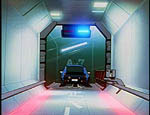

In the very first episode of the anime, we see Misato driving into what is presumably an underground tunnel and onto a car train, which descends into the geofront.
Like other trains seen later, it travels through the geofront itself, rather than being fully enclosed underground.
Meanwhile in episode 11, we see that cars can just drive straight into NERV via tunnels, and not only that but straight into central command

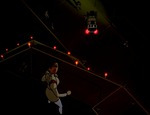
Which, well, seems problematic from a security standpoint. But this also leads into my next topic, which is where is NERV HQ?
Now ok, yes, it's obviously in the Geofront and we even see a big fucking pyramid, but that's not all of NERV.

It's implied that the pyramid is just "tip of the iceberg" so to speak, with the rest of the facilities buried within the floor of geofront. This would also explain how the evangelions are actually able to launch, since they can't exactly go through the big open space in the center of the geofront, and so their launch tubes must be located within the earth around it.
What does this have to do with cars? Well given that we see Hyuga commandeer a car and drive it into a tunnel during the power outage in episode 11, it's safe to assume that the tunnel slowly descends along the edge of the geofront's wall until it reaches central command, although likely branching quite a bit before then.
So with cars out of the way, let's move onto the next bit: Trains.
Now obviously yes, trains have an important symbolism in the series, but that's not what we're here for is it? I believe the first instance of a train to NERV HQ is in episode 5, when Shinji & Rei take the underground monorail, which is seen again in episode 11.


However, this train doesn't simply send you to HQ, as seen in episode 5 you have to go through the automated gates first.

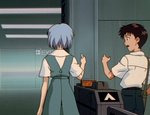
However, as seen here, the gates seem to lead directly into NERV itself, with the iconic green walls visible through them when open.
And yet, these gates appear again in episode 11, after the power outage, and look to be identical.
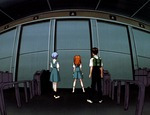

However, as mentioned previously there's no power by this point. So there are a few options here, each with their own flaws:
These gates are under the geofront and lead directly into the underground portion of NERV. How did the pilots get here without power, and why did they return to the surface in the next scene?
These same gates appear in lots of locations, both at aboveground entrances and in the geofront itself. Entirely possible, but boring.
The subway doesn't go deep underground, and instead circles the city at the surface level, and these gates simply lead into a portion of NERV's facilities that are closer to the surface.
Option 3 is my preferred option, since option 2 would likely mean employees would have to scan their IDs twice to enter HQ, not to mention the additional step of getting a train ticket. That's right, the subway station is established to not use ID scanners like the gates do, as seen in episode 11:

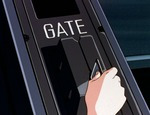
The biggest benefit to these gates leading to an aboveground portion of NERV is that it explains this room, seen in episodes 2 & 12, wherein we get a view of the geofront from above:

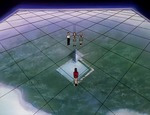
This is established to be the bottom floor of one of the buildings that retracts into the geofront, and yet seems to be part of NERV itself, given its usage.
But then there's another issue, that being whatever this fucking hallway from episode 11 is:


This is very clearly part of NERV, and yet it's both at the surface AND accessible without going through the gates, as the trio head here after the gates fail to open.
I'm gonna be honest, I don't really know what this hallway is.
Where do all the doors go? They can't be maintenance tunnels, as we see Route-07 in the very next shot and it is noticeably different from the fancy electronic doors of this section. Why does NERV even have this hallway? And why is it not locked behind the gates like everything else? There's a lot to unpack here.
Anyways, this hallway is the reason why I know that the gates from the previous scene can't lead into the underground portion of NERV itself, since why would they bother heading all the way back up to the surface?
Now, Route-07, as previously mentioned, is clearly a utility corridor or maintenance tunnel of some sort, which makes sense given the abundance of NERV surface infrastructure, such as the eva plugs, missile silos, and equipment elevators.
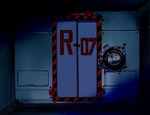

And once the pilots actually enter it, you can see a remarkable difference in it from the clean surface hallway, full of exposed pipes instead of polished surfaces.
This appears to be the final method of entering NERV in any sort of normal fashion, with this labyrinth of tunnels and airducts that lead down around the edges of the geofront and down into HQ.
But why did they bother with a maze when they could've just gone down the tunnel from earlier???
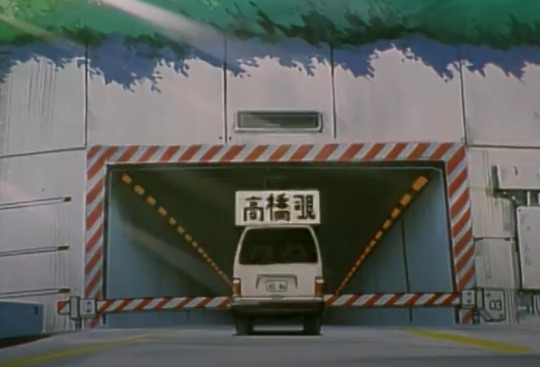
16 notes
·
View notes
Text










On October 16th 1995 the Bridge to the Isle of Skye opened.
Prior to the opening of the bridge the main route to Skye was by the ferry between the 2 villages Kyle of Lochalsh and Kyleakin. The ferry service was operated by Caledonian MacBrayne the short route of about 500m took 5min, at peak times there was often queues to use the ferry.
The bridge construction started in 1992 built by the Scottish company Miller, but designed by a German engineering company DYWIDAG Systems International in collaboration with civil engineering firm Arup.
The main bridge is a concrete arch, supported by two piers. This connect Skye to the small island called Eilean Bàn, the rest of the bridge is level across to the mainland. The total distance across is 1.5 miles. The main arch is about 35m high with around 30m clearance for boats on high tide.
Eilean Bàn (White Island) is the small island upon which the main arch of the bridge rests.
The island has a 21m high lighthouse just below the bridge arch. The lighthouse keepers (before automation in the 1960s) stayed in the cottages on the Island. These cottages where then purchased by Gavin Maxwell who is best remembered for is work with otters. Maxwell did many interesting things including writing wildlife books, his most famous is called "The Ring of Bright Water”.
These days the island is a wildlife reserve being managed by the Bright Water Trust. One of the cottages is now the Maxwell museum. This is a reconstruction of Maxwell’s 40ft living room, containing original artefacts, recreated by Virginia Mckenna of the Born Free foundation.
Most people wanted the bridge, but the way in which it was funded was conversional. Rather than the UK government paying for it, the government allowed it to be privately funded. Then granted a licence for the private company to charge tolls. It was said to be the most expensive road bridge in Europe.
This clearly upset many people. Locals on Skye setup a campaign group called SKAT (Skye and Kyle Against Tolls). After years of campaigning, legal challenges and then the setup of the new Scottish parliament in 1999 the leading political parties made it a priority to have the tolls abolished.
On the 21st of December 2004 the bridge was purchased by the Scottish Government and made free to cross.
42 notes
·
View notes
Text
The Cost of Delay: How Lead Routing Software Solves Speed-to-Lead Issues in SaaS
In the competitive SaaS landscape, potential customers demand immediacy. When someone signs up for a free trial or product demo, every minute of delay reduces your chance of converting them. According to industry benchmarks, responding within 5 minutes increases conversion rates by over 400%.
Without smart lead routing software, these leads might sit in inboxes or get overlooked. By integrating routing software with CRM systems, SaaS companies can automatically assign leads based on product tier, use case, or account size. The system prioritizes high-intent leads and ensures rapid follow-up.
Pain Points Addressed:
Missed opportunities due to slow responses.
No prioritization of enterprise vs SMB leads.
Reps unsure which leads to engage first.
What is Lead Routing? In SaaS, lead routing ensures free trial users, demo requests, or pricing inquiries are automatically assigned to the most relevant rep in real-time.
What is Round Robin Lead Routing? The software distributes leads equally among SDRs and AEs to prevent overload and promote fairness.
How to Improve Lead Routing:
Score leads and sync scoring to the routing logic.
Route high-priority leads to senior reps.
Use engagement tracking to re-route leads if no action is taken.
How to Set Up Lead Routing in Salesforce:
Setup > Lead Assignment Rules.
Add conditions (industry, deal size, feature needs).
Use lead routing software for weighted or rule-based distribution.
Set alerts for first contact deadlines.
Conclusion: SaaS businesses thrive on speed. Implementing lead routing software means fewer missed opportunities, faster response times, and more personalized outreach—leading to higher conversion rates and improved customer satisfaction.
0 notes
Text
Automated lead routing software
Automated lead routing software streamlines the process of assigning leads to sales representatives based on predefined rules such as geography, industry, or lead score. It ensures timely and efficient distribution, integrates with CRM systems, supports multi-channel lead sources, and provides reporting for analysis. The goal is to optimize lead management, increase response times, and improve overall conversion rates. https://www.leadangel.com/lead-routing/
0 notes
Text

Humans are weird: Hubris before the fall
( Please come see me on my new patreon and support me for early access to stories and personal story requests :D https://www.patreon.com/NiqhtLord Every bit helps)
A decade ago there was a powerful world by the name of Oma that was the crown jewel of the Omak Domain. Rich with natural resources and rare metals, it was able to establish a powerful trade network that generated billions of credits monthly leading to the people of Oma to grow fat with decadence. This led to a rapid degradation of their societal values to such an extent that they believed that they and only they were truly worthy of running galactic trade and began pressuring their neighboring governments to relinquish trade control of their domains to them.
When they finally approached the humans they sent forth a trade delegation to their parliament. This delegation did not present a sympathetic view of their stewardship, nor a presentation outlining the benefits of their management skills in intergalactic trade. No; this delegation strode into the terran parliament and denounced human trade standards as inferior and unworthy implementation between galactic powers.
No strangers to prideful boasting, the humans naturally took great offense to the grand standing of the delegation and cast them out without even hearing their full proposal. In response, the Oma began sanctioning the terran domain; isolating its trade routes and starving it off much needed resources.
For months the human diplomats tried to reach out to the Oma to find a political solution, but each attempt was met with the repeated message “Submit”.
As time passed and riots began to break out across human worlds from the lack of materials, the terran government finally had enough and dispatched a war fleet to Oma. The fleet was comprised of nearly three fifths of their entire naval power and was spear headed by the latest Herald class battleship “Saladin” with the equally famous Admiral Timmins in command.
Being comprised of mainly trade ships; the Omak Domain navy was primarily built around fast moving frigates, destroyers, and smaller patrol craft capable of catching pirates that preyed upon their shipping lanes. They were little more than a speed bump to the well-disciplined prowess of terran armada and was swept aside easily as the human ships made for orbit directly above Oma. Yet even with this encroaching ring of steel the Oma public did not panic.
Unlike their navy, the Omak Domain’s ground forces were substantially better in comparison. They had fought many ground wars to secure trade outposts, mining operations, and subjugation camps and were thusly made up of a hardened collective of veteran soldiers and automated war machines that were capable to five terran soldiers. So when the human fleet finally did position itself in orbit above Oma, the Omak military was confident they would repel any invasion attempts made by the humans; even going so far as to openly mock Admiral Timmins in a direct communique that not one human soldier would live to set foot on their world.
To their surprise Admiral Timmins agreed to those terms and began the battle.
From the launch bays of every terran ship came hundreds of heavily armed fighters, bombers, drones, and reconnaissance craft that swarmed through Oma’s atmosphere. Not a single lander or ground soldier was deployed as the Admiral coordinated a planet wide devastating air campaign of destruction.
The Omak air force was overwhelmed in a matter of hours by the constant waves of enemy aircraft and found itself further crippled as their launch sites were surgically struck from orbit by human warships. When the last of the Omak air power was expended the human air power had complete control over the skies of the planet.
Civilian targets such as cities and towns were ignored; but the precious foundries, factories, and mining complexes that had given the Omak people such wealth were reduced to little more than burnt pieces of metal and ash. The Omak rulers watched as their life blood of commerce was taken from them one continent at a time and sent countless messages to the human fleet for peace. Their reply was always a single word that none of the Omak would agree to.
“Submit.”
By a month’s end the world of Oma was little more than a smoldering crater. Gleaming cities now stood as silent watchers over miles of burnt landscapes and wasted industrial complexes. The people who had only known wealth and power were now left to wander the ruins of their former trade empire as the human fleet still held orbit over the world. Fragments of the Omak Domain attempted to bypass the human fleet to deliver supplies but each attempt was met with the humans either seizing the ship and the valuable cargo or destroying it just as it was about to land.
It didn’t take long for the previously subjugated peoples that had relinquished control to the Omak to begin rising up once more and regaining their sovereignty. Some the newly freed powers sent their own delegations to the human fleet and kneeled before Admiral Timmins; thanking the humans for bringing their oppressors low. Each time the Admiral would thank the aliens and invite them to the viewing decks so they could look down at the burnt world that had once held them so firmly under its thumb.
In a way it was both a gesture of friendship and a warning to all those that would come after; that the realms of man would never take kindly to the hubris of fools.
#humans are space oddities#humans are space orcs#humans are insane#humans are weird#scifi#story#writing#original writing#niqhtlord01#ai generated art#bing image creator
99 notes
·
View notes
Text
Elon Musk asserted last week that before any US federal employee can retire, their paper records have to be processed more than 200 feet underground in an old limestone mine located in rural Pennsylvania, which he said often takes months. “And then the speed—the limiting factor is the speed—at which the mine-shaft elevator can move determines how many people can retire from the federal government,” Musk said, standing next to a seated President Donald Trump in the Oval Office. “And the elevator breaks down sometimes, and then nobody can retire—doesn’t that sound crazy?”
While Musk’s comment about elevator dependency is overstated—the mine has many entrances and exits, as well as a road leading in and out that golf carts and other vehicles can drive on—his general point about inefficiencies within the federal retirement process is true. The Office of Personnel Management, which functions as the human resources department of the US government, tells retirees to expect a three- to five-month wait to process their applications. And retirement paperwork for federal employees does route through a storage facility in a repurposed limestone mine in rural Boyers, about 50 miles north of Pittsburgh.
When the system at Boyers was first established decades ago, putting retiree archives and processing files under one roof that was both remote and secure made a lot of sense. But over time, a systematic lack of resources, combined with repeated failed attempts to automate and digitize, created the “sinkhole of bureaucracy” that is the federal retirement hub today.
Six years ago, the Government Accountability Office reported that the OPM’s retirement system was still plagued by a “continuing reliance on paper-based applications and manual processing.” The agency's average retirement file processing time was about 60 days in 2019, which is only a modest decrease from 1981, when it took 98 days, but the agency processed almost twice as many applications.
But David Carmicheal, who recently retired as state archivist of Pennsylvania and has corresponded with staff at the Boyers facility, tells WIRED it’s a mistake to only view OPM’s process as “woefully outdated.”
“Much of the work that goes on at Boyers, as I understand it, is digital, so the idea of people trundling piles of paper through dark mine shafts is absurd,” Carmicheal says. “In fact, these facilities are meant to protect you and me by protecting the records that safeguard our legal rights, our public benefits.”
When reached for comment, the Government Accountability Office referred WIRED to its most recent publications. The Office of Personnel Management did not respond to a request for comment.
Going Underground
The Civil Service Commission, the predecessor of the OPM, started mailing retirement files to Boyers in 1960 with the intent to archive them “forever.” The CSC was one of many agencies that took advantage of repurposed mines and caves during the Cold War, seeking enhanced protection for sensitive materials in the event of a nuclear catastrophe.
The Boyers mine was operational from 1902 to roughly 1959 under the helm of US Steel. When high operating costs and dwindling demand for limestone caused the business to decline in the 1950s, US Steel employee Larry Yont saw an opportunity to repurpose the site as a storage facility and, with the help of civil engineer and mine superintendent Russell Mitchell, went on to found National Underground Storage. It was later bought by the company Iron Mountain in 1998, which owns and leases the Boyers mine to this day.
Along with the Civil Service Commission, other federal agencies, including the National Archives, the Office of Civil Defense (the precursor to the Federal Emergency Management Agency), and the Social Security Administration began storing records in the Boyers facility around the same time. J. G. Franz, then office manager of the Boyers mine, told a newspaper reporter in 1966 that federal agencies have “backup equipment for everything” stored in a special area of Boyers to protect the records in the event of nuclear fallout.
Franz told a local newspaper that workers “hope we will never have to worry about a nuclear explosion,” but that if one happened, the mine would be safely sealed off, according to newspaper archives reviewed by WIRED. “The mine is equipped with a 30-day supply of food and supplies for all of the employees.”
At the time, the staff at Boyers were reportedly able to process about 600 pounds of records each day bussed to the facility straight from Washington, DC. They relied on the recently constructed interstate highway system for timely deliveries. In fact, the federal government built an exit off Pennsylvania’s Interstate 80 specifically for “quick access to the mine in case of an emergency,” according to an article in the Pittsburgh Press.
There are other practical benefits that make old mines a good place to store records. For one, their typically rural and secluded settings create a layer of natural security from other types of threats. Repurposed mines provide “excellent fire protection,” and immunity from events like “flood, theft, civil disorder, aircraft crashes, tornadoes, lightning,” noted a 1999 Iron Mountain presentation for the National Archives.
Carmichael tells WIRED that access to the underground facilities he’s visited tend to be tightly controlled, often through heavily guarded entrances. These facilities also frequently have maze-like designs that would likely discourage or confuse thieves if they somehow got inside.
Several current managers of repurposed limestone mines told WIRED that their caves are naturally between 55 and 70 degrees Fahrenheit, optimal temperature for most storage situations. John Smith, director of industrial real estate for the company that manages the limestone storage facility Carefree Industrial Park near Kansas City, Missouri, said that this means utility costs are “dramatically lower” compared to above-ground facilities. His main expenses are associated with ventilation, since caves tend to be very humid.
It All Goes Wrong
Shortly before the Civil Service Commission arrived at Boyers, the US federal retirement apparatus was a mess. A 1951 government report found that “an adequate record system” wasn’t even in place yet and urged Congress to “insist” one be created. At first, it seemed like the team at Boyers was able to turn things around. The News-Herald reported in 1966 that with just 55 employees, the system at the mine was operating “with the same efficiency and effectiveness as it used to in Washington, DC.”
However, as the number of retirees continued to climb, things fell into disarray. By the early 1980s, the Office of Personnel Management was being audited to find the root causes of excessive delays in processing retirement claims. In 1981, the Government Accountability Office recommended that OPM “develop a long-term plan for automating the retirement claims process.”
OPM tried to launch an automated system in 1987, only to shut it down in 1996 when it failed an independent review. It began planning a new system, but gave up in 2001 and decided to contract the work out. The contracts weren’t awarded until 2006. The system they eventually built, RetireEZ, was finally launched in 2008, but it too was promptly shut down due to “quality issues.”
Little progress was made until 2013, when OPM launched a new “strategic vision” for a totally “paperless system.” Around that time, the agency was able to partially digitize the retirement process, allowing retirees to receive 80 percent of their pension quickly. But to get the full value, physical files still had to go through Boyers, according to a 2014 feature story in The Washington Post.
By 2019, the Government Accountability Office reported that OPM didn’t have enough money to finish digitizing. The agency was then piloting what it called the Electronic Retirement Record system, which was supposed to replace hard copies altogether. As part of the improvements, OPM was also trying to fix “inconsistent data between electronic and paper records,” according to the Government Accountability Office. Boyers workers would sometimes have to track down the physical copies of records by navigating through what had become essentially a small city of shelves and files, or type up other files that weren’t digitized.
Despite all of these efforts, the OPM still hasn’t finished digitizing the retirement process. It’s been a decade since the agency updated its internal guide for processing retirement applications. The Government Accountability Office attributed the slow pace of progress to “the continuing reliance on paper-based applications and manual processing,” lack of staffing, and OPM frequently receiving incomplete submissions.
Musk and DOGE have defunded and started to hollow out a slew of government agencies. While the centibillionaire has identified Boyers as a prime example of government inefficiency, he hasn’t described a clear vision for fixing the retirement system.
Despite their shortcomings, Carmicheal tells WIRED that it’s important to remember why government bureaucracies and record-keeping systems were set up in the first place. “I’m just thankful that we have had a long history in this country of governments that care about protecting their citizens,” Carmichael says, “and that includes safeguarding the records that document our rights and the responsibility of governments toward us.”
8 notes
·
View notes
Text
the Nephokinetic
(Users can utilize vapor in combat, whether it be releasing waves of mist to disorientate their opponents or conceal themselves in order to land sneak attacks, or using vapor to create weapons or having it accompany the user's own attacks.)
RPV was a man down. Jaune Arc their former leader having vanished one night, for no discernable reason, at least to them. So after missing the 40th Vytal Festival due to being a member short, the trio moved into their second year... proving their ability to cope and move forward, despite their disadvantage.
/==/
Pyrrha, Ren and Nora disembarked the bullhead. The small village they were sent to inspect, had no landing pad so the vehicle had to land in a nearby prepared area. Behind them Professor Peach stepped off. It was a second year supervised inspection mission.
The goal of the exercise was to teach the students how to see the strengths and weaknesses in a settlement or hamlet's defensive structures. To help them in those times they were dispatched to protect a settlement how to best utilize the resources at hand.
Their approved site was Fort Vale. A heavily fortified community was situated near the coast to the east of Vale proper, however for some reason while on route the destination was changed to their current location. A small unnamed village of maybe a dozen families or so, protected by a stout wooden palisade, and a few automated sentry turrets.
Peach knew at one glance the place was a death trap. Any serious Bandit or Grimm assault and the place would fold like a house of cards. Yet Peach was also aware of the side objective. There was someone of interest to Ozpin in the area... and she and her charges were the closet available team. Even if team RPV was a member short.
The trio of students lead by Professor Peach closed upon the sturdy-looking main gate. Showing her ID she and her charges were quickly allowed entry. Once past the gate Peach turned to face RPV.
"Now. I want you all to wander about. Take you time. We'll meet back at the gate in a hour." Peach let her eyes glid over the three young adults. "Pay close attention, and when we get back together I want to know from each of you what is good about these defenses... and what is bad. Any questions?"
Ren raised his hand.
"Mr Ren?"
"I thought we were supposed to be inspecting Fort Vale? Is there a reason for..." Ren didn't finish but looked around. The statement was however made.
"It was changed mid-route." Professor Peach informed the trio. "But the assignment is still the same and what you see and deduce here is applicable in other places. Any further questions?"
Pyrrha and Nora remained silent.
"Very well get to it. I'm going to have a chat with whomever is in charge of this place."
It took a little prodding and about twenty minutes but soon Peach found herself leaning against the counter of the General Store, speaking to the proprietor, who just happened to also be the woman in charge of the small settlement.
"So what brings Beacon out here?" the woman named Brittany Birch. "Should I be telling people to start packing?"
"No. It's an inspection exercise, and in fact I was going to ask you if there was a reason for us to actually be here instead of Fort Vale?"
"Well I can tell you we've not put in a call in for Huntsmen." Brittany replied, "No real need once the young fella showed up."
"Young fellow?"
"Yeah, young guy, was just wandering the road. Arrive about three weeks ago. Good thing too..."
"Why?"
"Had a small grimm incursion happen a couple days later." Brittany relayed, "Bad for us too. Pushed our defenses all most to the bring..."
"How big of a group?"
"One or two dozen." Brittany replied, "Nothing a larger settlement couldn't handle, but as you can see... we're still just scraping by."
"Well I assume you made it through... you're still here, obviously."
"Well it was because of the kid." Brittany informed Peach, "Without him we would have been over run."
"Was he that strong a fighter? Up to two dozen grimm is still a task to handle by one person." Peach commented, "Or did he have a strong semblance?"
"Well I'll say this... It was something else."
"What do you mean?"
"I don't really know how to explain it... but the kid used the grimm's own bodies against each other..."
"That makes no sense. Did he control a grimm and make it attack the others?"
"No... you know how a grimm evaporate after dying?"
"Yes."
"Somehow he manipulated that... used it against the pack. I mean it was seriously disturbing... the more grimm that went down, the more powerful and plentiful his attacks and defenses were..."
Peach stood there in silence, her lips pressed together. What the head-woman was speaking off... was impossible. Someone capable of using the essence of grimm as a weapon? There had to be more to it.
"Is this... individual still in the community?" Peach inquired. "I would like to speak with them... if I could."
"He should be. For all his help I put him up at my house. He's got a room in the attic. Private, warm and safe."
The incessant and rapid ringing of an bell sounded in the distance.
#rwby#professor peach#pyrrha nikos#lie ren#nora valkyrie#vapor based semblance#no fall of beacon#nephokinesis
18 notes
·
View notes
Text
How AI Conversational Platforms Boost Lead Generation and Conversion Rates
AI-powered conversational platforms have become a necessity for marketers who need to create, connect, and convert leads in a short span of time. Since they can mimic the human touch and work 24/7, conversational platforms are changing the dynamics of how brands converse with prospects and how they close deals.

This is how they're making a positive impact.
Instant Engagement, Zero Wait Time
Today's customers need things in real time. AI-powered chatbot and voice assistants capture visitors the moment they land on a site and respond to questions, offer guidance, and stop drop-offs. That first interaction is usually the one that converts casual visitors into leads.
Qualifying Leads Automatically
AI platforms can be configured to pose intelligent, qualifying questions to identify a visitor's intent, budget, or timeline. This can be advantageous to businesses that focus on high-quality leads, it helps them to shorten response time and direct route prospects to the appropriate sales representative
Personalized Interactions That Convert
AI solutions scan user activity and adjust conversations to match. From recommending the appropriate product, providing a discount, or addressing a pain point, personalization builds trust and enhances conversion potential. This shows a customer that you remember small things about them, like their past purchase history and their likes and dislikes. This enables them to concentrate and sense more connected with your brand.
24/7 Lead Capture
Salespeople cannot work 24/7, but AI can. These sites capture leads 24/7, 7 days a week, across time zones, so you never miss a lead. This also helps to reach your customers on public holidays and weekends when your staff may not be working. This helps to boost your bottom line around the clock.
Seamless Integration with CRM Systems
New conversational platforms are natively connected with CRMs so that you can automatically log lead information, automate follow-up sequences, and track real-time conversion analytics.
Wrapping Up
AI conversation platforms are not chatbots, they're master lead generators. With real-time engagement, smart qualifications, and personalized experiences, they help businesses convert interest into action. For businesses looking to grow smartly, these tools not only keep the conversation alive but the conversions as well.
3 notes
·
View notes